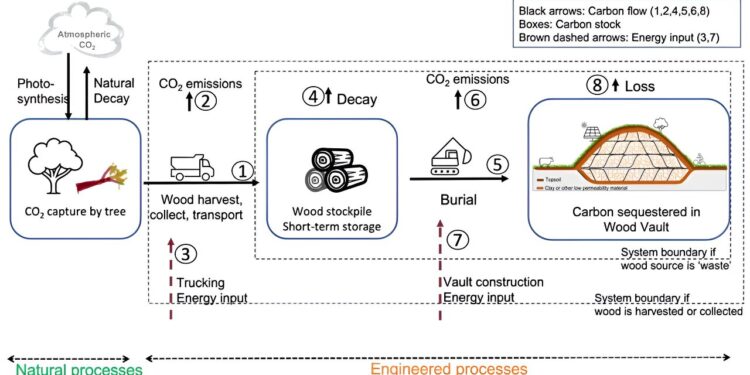Process flow diagram (PFD) of the wood landfill project. Credit: Science (2024). DOI: 10.1126/science.adm8133
A team of diverse researchers from the University of Maryland, working with a colleague from the Department of Agriculture, Fisheries and Food, Canada, reports the viability of burying biomass as a means of expensive to store global warming. carbon.
In their study, published in the journal Sciencethe group analyzed a log that had been naturally buried under a layer of clay for thousands of years. Yuan Yao published a perspective on the research in the same journal issue.
Carbon and other greenhouse gases in the atmosphere cause global warming. To avoid possible catastrophic impacts, humans must stop emitting greenhouse gases, particularly carbon dioxide, into the atmosphere.
However, scientists also found that because a large amount of carbon has already been released into the atmosphere, some must be removed to prevent further warming. To date, a number of ideas have been proposed on how to achieve this, most of which have proven costly. In this new study, the research team suggests a much less expensive alternative: burying biomass.
Previous research has suggested that burying biomass could be a way to sequester carbon. Most plants extract carbon from the air and release it when they die. If these plants were buried, the researchers suggest, the airborne carbon they absorb would be held captive, preventing it from reaching the atmosphere.
The research team found a natural source of evidence for this idea, a log discovered while digging a trench in Canada. Dating showed that it was around 3,775 years old and was remarkably well preserved thanks to the clay in which it was embedded. Tests showed that the log still contained 95% of the carbon it had absorbed during its lifetime.
Finding that clay is abundant in soils around the world, the researchers calculated the cost of burying logs and other types of biomass in order to sequester carbon. They found that it would only cost $30 to $100 per ton, compared to $100 to $300 per ton with other methods.
They further suggest that it should be possible to sequester up to 10 gigatons of carbon per year simply by burying biomass.
More information:
Ning Zeng et al, a 3,775-year-old wood burial supports “wood vaulting” as a sustainable method of carbon removal, Science (2024). DOI: 10.1126/science.adm8133
Yuan Yao, A woody biomass burial, Science (2024). DOI: 10.1126/science.ads2592
© 2024 Science X Network
Quote: Ancient buried log offers evidence of biomass vaults as inexpensive way to store carbon responsible for global warming (September 27, 2024) retrieved September 27, 2024 from
This document is subject to copyright. Except for fair use for private study or research purposes, no part may be reproduced without written permission. The content is provided for informational purposes only.



